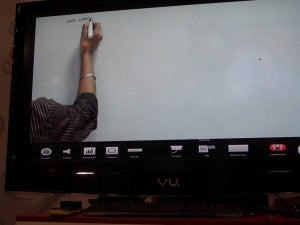
A couple of months ago we discussed the decline of business travel and the rise of high quality video conferencing from companies like Cisco, HP, and Polycom. The trend of telepresence is on the rise, and Indian based Vu Technologies is hoping to snag a big share of the market by offering high quality video on regular high speed bandwidth. The total cost according to reps at CES: about $3500 per unit which includes camera and server. While that’s nearly a hundred times more expensive than Skype and a cheap webcam, it’s also one tenth (or one hundredth) of the price of a current Cisco system. Smaller businesses could now have access to professional video conferencing at a fraction of the cost. While it’s better known for making luxury TVs, Vu’s new telepresence may help usher in a new era of business where we don’t travel the world, we shrink the distance between us.
There are three distinct sizes to video conferencing. The largest corporations can afford super sized bandwidth connectivity on customized high speed lines. This allows for amazingly crisp video conferencing provided by Cisco, Polycom, HP and others. Yet this improved connectivity doesn’t just cost more to put in place, it can run you thousands a month in provider costs. The smallest size, individual homes, rely on cheap webcams, programs like Skype, and bandwidth that often leads to poor quality. As I mentioned when we heard that Cisco is after this market, despite that poor quality the utter cheapness of those systems makes them unlikely to be supplanted by better but more expensive competitors.
Which leaves us with the third market for video conferencing: small businesses. Trying to run a business on Skype could make you seem unprofessional, and trying to video conference with Cisco could make you broke. So there’s room for a new competitor. Vu’s reaching for that market. Their Vu Telepresence works over standard high-speed internet connections, and can still provide a 720p resolution that makes images appear crisp and clear. The secret, reps at CES told me, is the codec they use, which is reportedly “22% more efficient” than competitors’.
At CES, Vu had a few screens set up, and I had a chance to talk with employees in India and the US. There was a very small delay (often unnoticeable) and reported to be around 650 to 700ms. The picture quality was excellent, and I could make out small handwriting on a whiteboard and a legal pad. Reps also said that Vu Telepresence should be able to incorporate document sharing programs (like Google Wave) into the video, and that in about two months they would be looking to unveil some built-in speech to text software. Taken together, these capabilities would seem to make Vu Telepresence satisfying to anyone trying to have a meeting in two places at once.
According to their CES press release, Vu is looking to aggressively expand into US, Europe, and India markets. They may also offer Vu Telepresence locations where interested parties can rent a room with the equipment and talk to business associates in other cities doing the same. This village video conference system is a logical one, and I’m interested to see if it will form a substantial part of Vu’s sales.
Of course, even if Vu can’t snag small businesses from Cisco, Polycom, and HP, some other developer may. High speed bandwidth is becoming more common all over the world (Finland is even guaranteeing it to citizens) but the ultra-premium variety may take a decade or more to permeate into every-day use. Until that time, the middle-ground of telepresence is an open market. May the best, and hopefully cheapest, competitor win.
[photo credit: Aaron Saenz]



